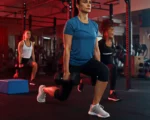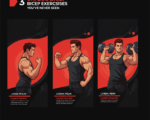Building muscle might seem like a daunting task, especially if you’re new to weightlifting. However, with a well-structured plan and some consistent effort, you’ll be on your way to achieving your fitness goals sooner than you think. This guide is tailor-made for beginner and intermediate lifters who want to develop a solid muscle-building routine. Let’s break it all down into actionable steps!
Why a Muscle-Building Routine Matters
A structured workout plan helps you build muscle safely and effectively. Without one, progress can be inconsistent, and the risk of injury increases. By focusing on proper form, rest, and progression, you’ll not only build muscle but also develop strength, endurance, and confidence in the gym.
Benefits of This Muscle-Building Plan
- Tailored for beginners and intermediates: Ideal for those just starting or who’ve trained sporadically.
- Focused on foundational lifts to maximize muscle growth and strength.
- Easy progression with gradual increases in weight and intensity.
- Includes rest and recovery time to prevent overtraining.
Now, let’s break this down into a six-step process so you can get started!
Six Steps to Create an Effective Muscle-Building Routine
1. Set Clear Goals
Define what you want to achieve with your training. Are you looking to gain size, improve strength, or simply learn proper form? Clear goals will dictate the structure of your workout plan. For beginners, focus on mastering fundamental lifts and building a base level of strength. Intermediates can start refining technique and progressively overloading for hypertrophy.
2. Choose a Training Split That Fits Your Schedule
The best workout routine is one that you can stick to consistently. Here are some beginner-friendly options:
- Full-body workouts (3 days per week): Great for beginners as they hit each muscle group multiple times a week.
- Upper/lower split (4 days per week): Ideal for those with moderate experience looking to add intensity and volume.
- Push/pull/legs split (3-6 days per week): Suitable for intermediates to add variety and target muscles more specifically.
Example full-body schedule (3 days per week):
- Monday
- Wednesday
- Friday
This ensures enough recovery while maximizing progress for beginners.
3. Focus on Compound Movements
Compound exercises use multiple muscle groups at once, making them perfect for building overall mass and strength. Ensure your workout plan prioritizes these key lifts:
- Squat (targets legs, glutes, and core)
- Deadlift (hits your entire posterior chain)
- Bench Press (chest, shoulders, and triceps)
- Pull-ups or Lat Pulldown (back and biceps)
- Overhead Press (shoulders and triceps)
- Barbell Row (back, biceps, and core)
Include accessory or isolation exercises (like bicep curls or lateral raises) sparingly to complement your compound lifts.
4. Start with the Right Volume and Reps
For muscle growth (hypertrophy), structure your sets and reps as follows:
- 3-4 sets of 8-12 repetitions for compound lifts.
- Incorporate 3 sets of 12-15 reps for isolation exercises.
This range is ideal for beginners aiming to build size while improving strength.
5. Prioritize Progressive Overload
Progressive overload is the process of gradually increasing the stress placed on your body through weight lifting. To grow stronger and bigger muscles, you need to challenge yourself by either:
- Increasing weights
- Adding more reps
- Improving form and control
- Reducing rest times
For beginners, increasing the load every 1-2 weeks or when lifts feel easy is a simple and effective approach.
6. Don’t Forget Rest and Recovery
Muscles grow when you rest, not during the workout. Here’s how to ensure recovery:
- Get 7-9 hours of quality sleep nightly.
- Rest at least 48 hours before hitting the same muscle group again.
- Active recovery (like walking or yoga) can enhance your progress and reduce fatigue.
Sample Beginner to Intermediate Muscle-Building Routine
Here’s a simple 3-day full-body plan to get you started:
Day 1 (Full Body)
- Squats: 4 sets x 10 reps
- Bench Press: 3 sets x 10 reps
- Barbell Row: 3 sets x 10 reps
- Dumbbell Shoulder Press: 3 sets x 12 reps
- Plank Hold (core): 3 sets x 30 seconds
Day 2 (Rest or Active Recovery)
Day 3 (Full Body)
- Deadlift (start light): 4 sets x 8 reps
- Overhead Press (barbell): 3 sets x 8 reps
- Lat Pulldown or Pull-ups (assisted if necessary): 3 sets x 10 reps
- Bicep Curls (dumbbell): 2 sets x 15 reps
- Side Plank (core): 2 sets x 20 seconds each side
Day 4 (Rest or Active Recovery)
Day 5 (Full Body)
- Leg Press Machine or Goblet Squat: 4 sets x 12 reps
- Incline Dumbbell Press: 3 sets x 10 reps
- Single-Arm Dumbbell Row: 3 sets x 10 reps (each side)
- Tricep Dips (bodyweight): 2 sets x 12-15 reps
- Russian Twists (core): 3 sets x 20 twists
Day 6 and Day 7 (Rest)
Nutrition Tips for Muscle Building
Remember, exercise alone isn’t enough. Here are some beginner-friendly nutrition principles to complement your routine:
- Eat enough protein (0.8-1 gram per pound of body weight). Lean protein sources include chicken, eggs, fish, and tofu.
- Stay in a slight calorie surplus to fuel muscle growth.
- Hydrate with plenty of water for performance and recovery.
- Incorporate healthy carbs (like oats and sweet potatoes) to power through workouts.
Be Consistent and Patient
Building muscle takes time and commitment. Stick to your routine, focus on proper form, and track your progress. Don’t rush to add more weight if your technique suffers. Remember, fitness is a marathon, not a sprint.
Looking for more detailed muscle-building plans? Check out Muscle and Strength’s Beginner Workouts for more inspiration. Start strong today, and you’ll thank yourself tomorrow!








